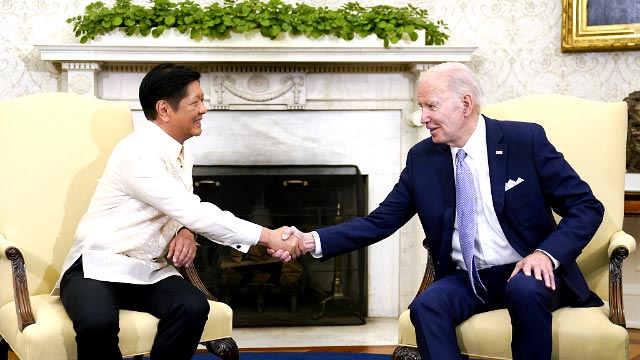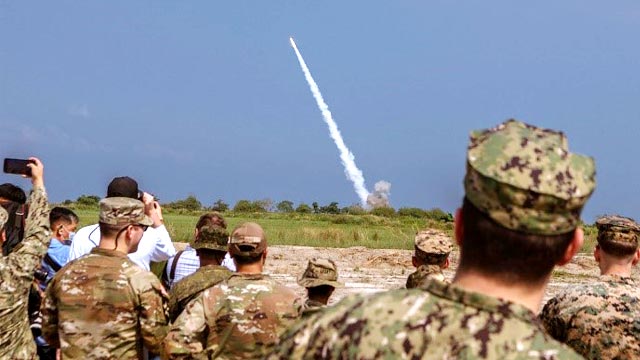South China Sea tops Biden-Marcos summit
Bobby M. Tuazon
China Global Television Network
02 May6 2023
Editor's note: Bobby M. Tuazon is the Policy Studies Director at the Philippine think tank Center for People Empowerment in Governance. He teaches international politics at the University of the Philippines. The article reflects the author's opinions and not necessarily the views of CGTN.

U.S. President Joe Biden shakes hands with Philippine President Ferdinand R. Marcos, Jr. as they meet in the Oval Office of the White House in Washington, D.C., U.S., May 1, 2023. /CFP
At a summit on Monday, U.S. President Joe Biden and Philippine President Ferdinand R. Marcos, Jr. agreed to solidify their defense alliance against Chinese "incursions" in the South China Sea (SCS) that "threaten" the security of the Philippines and its territorial claims.
The Philippine president's four-day official visit to Washington is being held only a week after the two countries' largest-ever annual joint drills named "Balikatan" (shoulder-to-shoulder), which lasted 18 days and involved nearly 18,000 forces. The drills were expanded to include the participation of forces from Japan and Australia, both close U.S. allies. The Philippine defense department also just announced that bigger war drills will be held in 2024.
On cue and in the course of the war drills, a near-sea collision between vessels of the China Coast Guard (CCG) and the Philippine Coast Guard (PCG) took place on April 23 in the waters of Ren'ai Jiao, also known as Second Thomas Shoal, which both countries claim. The video clips on the incident appear to show CCG vessels on routine patrol and approached by a smaller PCG vessel.
It is no coincidence that the PCG looked more aggressive as the Philippines was conducting intensive military exercises with the U.S. At the same time, nine Enhanced Defense Cooperation Agreement (EDCA) sites across the Philippine archipelago served as locations for the "Balikatan" war exercises and will soon become permanent hubs with plans for U.S. economic investments and evacuation centers for Filipino migrant workers, according to local defense officials.

A patriot surface-to-air missile is launched by the U.S. Military during a live fire drill at the Naval Education Training and Doctrine Command in San Antonio, Zambales, Philippines, April 26, 2023. /CFP
With all the EDCA sites – particularly in the northern Philippines – already being used to preposition U.S. forces and ammunition, the country has become a potential location for rockets, missiles and artillery systems to "counter" Beijing's influence.
The U.S. maintains a policy of ambiguity over Taiwan by officially upholding the one-China principle while supporting moves for "Taiwan independence" headed by the Democratic Progressive Party (DPP) with advanced weapons, an increasing U.S. naval presence in the area, and encouraging exchanges of official visits between the U.S. and its virtual ally.
At the moment, U.S. full-spectrum maneuvers in the SCS seek to bring air-backed U.S. maritime forces closer to the flashpoints of contention, giving them an advantageous position to counter China's influence. But this is realizable only with the cooperation of the Philippines and other U.S. allies in the Asia-Pacific, which will likely disturb regional peace.
Philippine Foreign Secretary Enrique Manalo had said that his government will not allow the use of EDCA sites in case of an armed U.S. conflict with China and that, in fact, the facilities target no third country. This declaration has, however, been rendered farcical given the visibility and noise of the U.S.-Philippine military build-up in these locations and also the increase in joint war exercises and emboldened maritime operations by the Philippine navy in the SCS as well.
The Biden-Marcos summit is but the latest step of a one-year, well-orchestrated strategy of the U.S. squeezing the Philippine president to turn from former President Rodrigo Duterte's China-friendly foreign policy and pivot to the U.S. The roadmap included early visits by Vice President Kamala Harris, Secretary of State Antony Blinken and Secretary of Defense Lloyd Austin. The efforts rewarded the Biden administration with expanding sites under the two countries' EDCA from five to nine, allowing the U.S. to preposition armed personnel and military equipment. Biden just recently announced his reelection bid for the 2024 presidential race and is expected to campaign on a platform of a tough and bellicose strategy on China, capitalizing on a growing anti-China public sentiment among Americans. This is also congruent with Marcos, Jr.'s pivot to the U.S. foreign policy.
Every piece is falling into place in the U.S. alliance with the Philippines to confront China. Despite the existence of bilateral dialogue mechanisms between Beijing and Manila to resolve territorial disputes peacefully, diplomacy is taking a back seat.
In the end, regional stability will be the first victim in the current geopolitical strains, which is a bane to the ASEAN policy of neutrality and non-interference. It may reach a point where a rethinking of risky geopolitical decisions is no longer possible.
- South China Sea tops Biden-Marcos summit
- Philippines split over increased U.S. military presence
- China-Russia ties on high note
- What are geopolitical implications of U.S. defense chief's visit to the Philippines?
- Configuring Philippines-China ties under Marcos, Jr.; Philippine Development Plan and controversial funds
- Is there prospect for the hybrid election system (HES)?
- MARCOS, JR. FACES GRINDING WOES; ARE REFORMS POSSIBLE?
- Marcos, Jr. pivots to the US; faces tough economic challenges
- CenPEG’s 16th book launched
- Sisa’s Vengeance: Jose Rizal’s Sexual Politics & Cultural Revolution
- Marcos, Jr. in cryptic ties with China as he commits to U.S. defense alliance
- Philippines - a geostrategic battleground?
- The other side of Shinzo Abe: historical revisionism, denial of war crimes
- Rightsizing and reengineering bureaucracy
- Nancy Pelosi’s history of belligerency on Beijing
- Indonesian leader's China visit: Elevating bilateral relations
- 14th State of the Presidency
The Marcos, Jr. Presidency: Key Challenges from the People's Perspective - The May 2022 Elections and the Marcos Restoration: Looking Back and Beyond
- Rethinking ASEAN ties with U.S., signs of another Cold War may be in the air
- A quest for peace in Europe
- Maelstrom Over the Killing Fields
- The Russians are coming!
- Disqualification cases roil Marcos camp; biggest Left political bloc backs Robredo-Pangilinan team
- A Race for Power of Political Dynasties
- On proclaiming a winning candidate
- CLASH OF POLITICAL DYNASTIES ACCENTS MAY 2022 ELECTIONS
- The Great Faith
- We need to renew 'new politics' for the May 2022 polls
- Major Presidential Bets Formalize Candidacies but Last-Minute Surprises still Possible till Mid-November
- The shadow of Bannon in Biden's anti-China strategy
- Biden's 'Pivot to Asia' at a dead end
- Is the US aching for a war with China over Taiwan?
- Dollars for America's war machine, human losses
- Learning from an awakened dragon
Center for People Empowewrment in Governance (CenPEG), Philippines. All rights reserved


